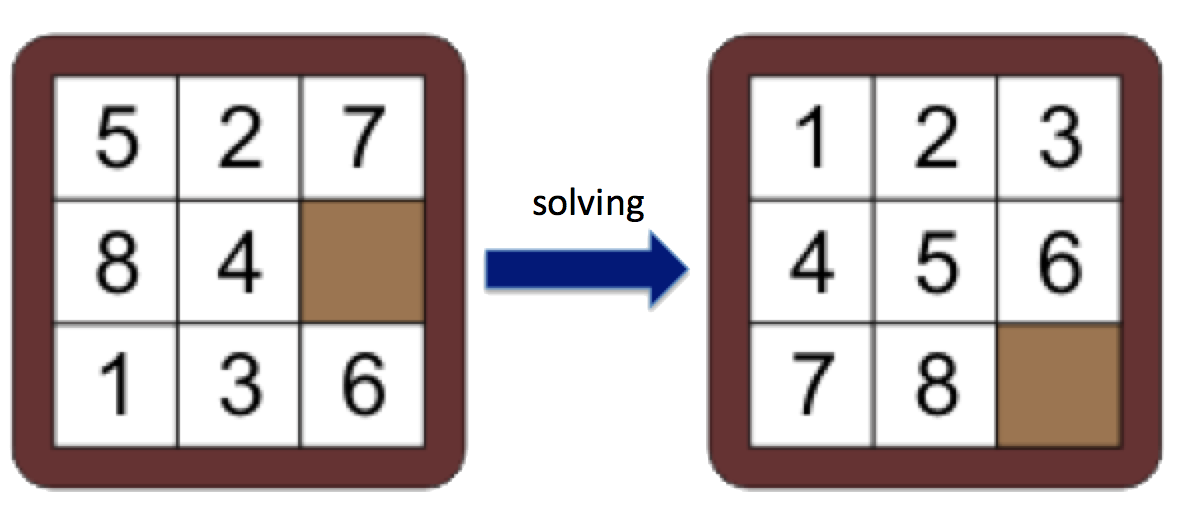SlidingBfsReference.py, added follow up questions, added description of Sliding puzzle with image and link to play onlineCopy the files in the directory ~cs61c/proj/02 to your proj2 directory, by entering the
+
+
As mentioned above, we are going to be solving the generalized Fifteen puzzle, which we call the Sliding puzzle (with input parameters width and height). + +This puzzle consists of numbered tiles in a random ordering with one tile missing. The objective of the game to place the tiles in order as shown in the image below, for the 3x3 case.
+ +
++If you've never played the game before, it might be helpful (and fun!) to try it here. That website allows you to play a 3x3, 4x4, or 5x5 puzzle. +
+ +To get started on the project, copy the files in the directory ~cs61c/proj/02 to your proj2 directory, by entering the
following command:
@@ -269,6 +280,8 @@ $ cp -r ~cs61c/proj/02 ~/proj2
SlidingBfsSpark.py is where you will put your MapReduce job to solve a (Width x Height) Sliding puzzle
proj2-1.txt is where you will put your answers to the follow up questions.
+ You are free (and encouraged) to define and implement additional helper functions, but they must be in SlidingBfsSpark.py. Changes you
@@ -290,7 +303,9 @@ $ cp -r ~cs61c/proj/02 ~/proj2
As described above, this MapReduce job will take as input a width and height describing a Sliding puzzle. Using the solution, it will repeatedly expand the BFS tree, and generate a mapping between every position and the level at which it is in the BFS tree.
-
More precisely, we expect your output to be a text file of the following form. (for example, for a 2x2 case):
+ We represent a Sliding puzzle as a Python tuple of strings. Each tile is an alphabetic character and the empty space is represented with a hyphen '-'.
Therefore, after running your MapReduce job, we expect your program to produce a text file of the following form. (for example, for a 2x2 case):
0 ('A', 'B', 'C', '-')
1 ('A', '-', 'C', 'B')
@@ -309,7 +324,7 @@ $ cp -r ~cs61c/proj/02 ~/proj2
Here's a recommended plan of attack:
SlidingBfsReference.py implementation and understand how it works. Start brainstorming with your partner how you can transform this into the MapReduce frameworkSlidingBfsReference.py implementation and understand how it works. Start brainstorming with your partner how you can transform this into the MapReduce framework. You will submit you and your partners answers to the following questions in proj2-1.txt.
+
+1. Some games (e.g., Rush Hour, Klotski, etc.) do not have a single solution, but a set of solution positions (and a single starting position). This is because those puzzles only care about the final position of a particular block, and don't care about the location of the other blocks. In terms of an API change, solution() wouldn't be a no-argument function that returns the single solution position anymore, but instead be a predicate that took in a position and returned whether it was in the solution set or not. Your friend suggests to generate all the permutations of blocks (or whatever else is being moved / rotated / changed in the puzzle), call them all solutions (level = 0), and proceed normally. What is one potential problem with this idea? (Hint: take a look at the number of positions in the 2x2 final solution and compare that with all the ways of permuting four pieces).
+
+2. What's a better algorithm to solve these kinds of puzzles? How would you modify your original solver? +
+ ++3. On the same note, what needs to be changed to solve loop-free puzzles, like Peg Solitaire. For every position, rather than the distance to the solution, what might you store? What changes would you make to your solver? In the case of Peg Solitaire, would it change the memory requirements of your solver? +
+You should test your code on one of the following servers. (See below for benchmark information). @@ -380,6 +409,11 @@ $ cp ~cs61c/proj/02/<NAME OF FILE> ~/proj2
proj2-1.txt
+
+
+ proj2-1 is due Sunday (10/26/2014). To submit proj2-1, use the following commands. You should just be turning in SlidingBfsSpark.py.
+
proj2-1 is due Sunday (10/26/2014). To submit proj2-1, use the following commands. You should just be turning in SlidingBfsSpark.py and proj2-1.txt.
$ cd ~/proj2 $ submit proj2-1